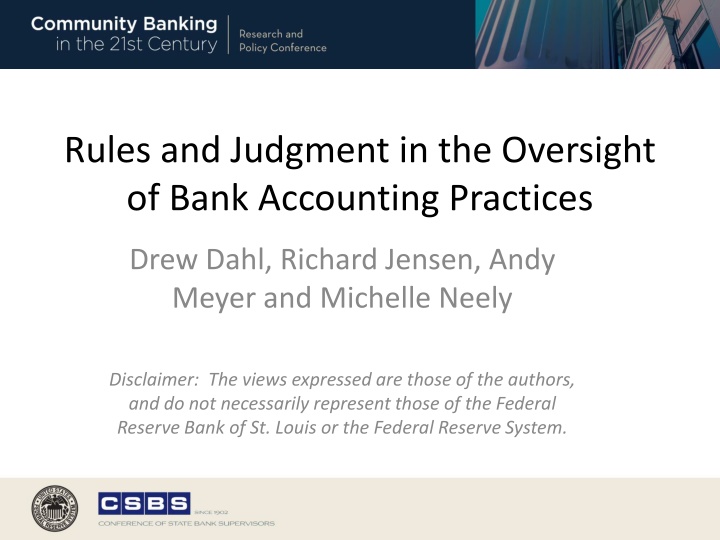
Insights into Bank Accounting Oversight Practices
Explore the implications of CECL regulations on bank accounting practices and regulatory judgment. Discover how regulatory tailoring and judgment impact loan loss accounting rules, especially among small banks. Learn about the changes in FASB standards and how banks determine loan loss charge-offs. Dive into a study analyzing bank conformity to accounting standards based on various factors like bank size, audit status, and management strength.
Download Presentation

Please find below an Image/Link to download the presentation.
The content on the website is provided AS IS for your information and personal use only. It may not be sold, licensed, or shared on other websites without obtaining consent from the author. If you encounter any issues during the download, it is possible that the publisher has removed the file from their server.
You are allowed to download the files provided on this website for personal or commercial use, subject to the condition that they are used lawfully. All files are the property of their respective owners.
The content on the website is provided AS IS for your information and personal use only. It may not be sold, licensed, or shared on other websites without obtaining consent from the author.
E N D
Presentation Transcript
Rules and Judgment in the Oversight of Bank Accounting Practices Drew Dahl, Richard Jensen, Andy Meyer and Michelle Neely Disclaimer: The views expressed are those of the authors, and do not necessarily represent those of the Federal Reserve Bank of St. Louis or the Federal Reserve System.
CECL is Coming! What happens when the goal of regulatory burden reduction meets the introduction of a new regulation? How do banks conform to existing rules? Does one size fit all?
Our Contribution Assess the existence of regulatory tailoring/judgment in application of an accounting rule Find evidence that regulators tolerate deviation from loan loss accounting rules, especially among small banks Use of judgment by regulators is enduring, rather than episodic, and applies to a broad segment of the industry, not just large banks
CECL Facts Change in FASB standard prompted by financial crisis CECL replaces the incurred loss model used to estimate loan losses and thus loan loss provisions Expected losses are estimated when the loan is made (rather than when loss becomes evident) Losses are estimated over the life of the loan Will be fully phased in by January 1, 2021
What We Tested Did banks conform to standard that charge- offs be directionally consistent with prior provisions? Did conformance vary by: Bank size? Audit status? Strength of management?
How are Loan Loss Charge-Offs Determined? LCO Ratio= fn {LLP ratio, bank size, audit status, managerial performance, LLR ratio, NPL ratio, probability of CAMELS downgrade, loan type concentration}
Our Sample Annual data for commercial banks with assets of less than $10 billion, 2006-2015 Approximately 64K observations Banks divided into 5 asset sized groups: Less than $63 million $63 million to $113 million $113 million to $194 million $194 million to $388 million $388 million to $10 billion
Regression Results by Size Categories Dependent Variable: LCO Coefficient <$63 M >$63 M <$113 M >$113 M <$194 M >$194 M <$388 M LLP (t-1) 0.46 0.44 0.42 0.47 LLP*C (t-1) -0.19 -0.17 -0.13 -0.07 Allow (t-1) 0.06 0.12 0.12 0.04 Nona (t-1) 0.04 0.04 0.04 0.03 Downgrade (t-1) .007 0.007 .008 .008 All variables statistically significant at 1% level, except allow (t-1) in the largest size group.
Key Findings Smaller banks have lesser capacity/incentive to link provisions with subsequent charge-offs Oversight by auditors improves the association between charge-offs and provisions This accounting discretion holds for small banks across all management ratings Greater tolerance of regulators for wider range of outcomes among smaller banks
Explanation for Small Bank Results Lesser threat to the DIF Lower relative LLPs, LCOs and CAMELS downgrade probabilities Possible recognition of relatively higher compliance costs Judgment more likely because of the types of loans small banks make
